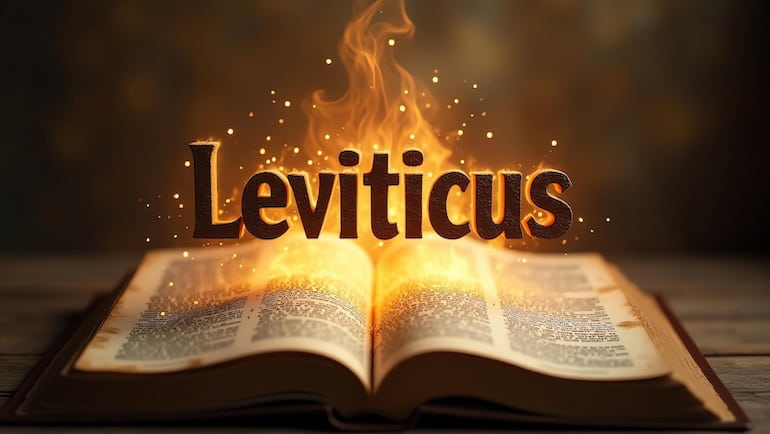Biblical references are at the heart of the divided reaction to the late Charlie Kirk following his assassination last week. Kirk, a fundamentalist Christian who also was part of Trump’s conservative political machine, drew ire from progressives and support from extreme conservatives for how he referenced Leviticus, and its passages encouraging condemnation and (in older translations) the stoning of gays and lesbians. But Kirk was using an outdated, disproven interpretation of Leviticus and its so-called “clobber passages.” Pastor Tyler Yost, in his second column knocking down the clobber passages, takes on the passage that Kirk incorrectly interpreted to condemn LGBTQ people.

Greetings, friends. I’m back with another column unpacking another one of those Clobber Passages.
This time, it’s the passage cited by the late Charlie Kirk: Leviticus 18:22, which reads, “Do not lie with a man as one lies with a woman, it is an abhorrence.” We’ll also tackle Leviticus 20:13, “If a man lies with a male as one lies with a woman, the two of them have done an abhorrent thing; they shall be put to death – their bloodguilt is upon them.”
These passages are loaded with misconceptions and misappropriations. As we did with the first edition of my “clobber passages” column, back in May, we need to keep some things in mind to understand their actual meaning.
The late Charlie Kirk, assassinated last week while speaking on a college campus and pictured above speaking in Tampa in July 2025, was misinformed in his interpretation of Leviticus and its “clobber passages,” writes Pastor Tyler Yost.
Biblical Translation Makes All the Difference
Most importantly, we need to understand that the word “as” was not originally in this text. It was added by the translators.
The original text is most literally interpreted as this: “And with a Male You Shall Not Lie the Lying down of a Woman.”
This is significant: it’s a translation decision that ends up inferring a direct likeness between homosexual and heterosexual intercourse, when the original wording was much less clear.
So what does that actual wording mean? It’s certainly an odd phrase for us English speakers.
Scholars believe this passage refers specifically to “pederasty,” or a sexual act between an older man and a young boy. This essentially means that the passage is conflating the sexual relationship between an older man and young boy with “vaginal receptivity” (“the lyings of a woman.”)
Here, we must apply what we shared last month: the hierarchy of penetration. In the ancient world, penetration was considered a hierarchical act – and lowest on the hierarchy were those who received the penetration, or were unable to be the penetrator.
The act of pederasty placed some males at the same hierarchical level as women – and it was this disruption of power, rather than homosexuality, that was the violation.
Next, let’s look at how this passage is worded: “the lying(s)-of-X.” A key contextual point matters here: this formula phrase only pops up in Scripture when the subject is incest.
With this literary and historical context, those two passages in Leviticus suddenly become even more clear: they are referring to incest, along with pederasty. Those are the actions condemned by the Levitical Purity Codes.
Leviticus 20:13 expands on the command in chapter 18 by adding a punishment for those who don’t comply with the command. If we are mindful of the context of chapter 20, we see something very interesting.
Leviticus 20:1 says, “The Lord said to Moses, ‘say to the Israelites: Any Israelite or foreigner residing in Israel who sacrifices any of his children to Moloch is to be put to death.”
After this, in Leviticus 21, is a list of offenses that result in the death penalty. They’re about idolatry, incest, and pedophilia rather than consensual loving queer relationships.
Leviticus is about the cult, not the queers
Why is this important? It’s important because during this time period there was a cult, Moloch, that was considered lustful in its very practice. 3 Leviticus 20:5 reads, “I myself will set my face against him and his family and will cut them off from their people together with all who follow him in prostituting themselves to Moloch.”
This Moloch cult was known for fornication (prohibited sexual activities – as referenced in Isaiah 57:3) and for infanticide (referenced in 2 Kings 23:10). It was also known for sex as worship, and the Bible specifically states that it is unlawful to spill one’s seed in the worship of another deity or angelic being (Genesis 6:1-4, Jude 1:7-12).
The sins worth death are those of the cult, not of being gay.
The bottom line is this: when interacting with biblical passages, we must discern where the passage came from, when it was written, who wrote it, and why it was written in the first place.
Without understanding all these elements, you are working with an incomplete picture. As we all know, a picture is worth a thousand words – but just like some words, an incomplete picture can steer us in the completely wrong direction.
This column originally appeared in the July 2025 print magazine of MainStream MultiMedia. Do you have questions about Biblical passages used to condemn LGBTQ+ people? Send your questions to Pastor Tyler Yost at pastor@churchofpeaceucc.org.


